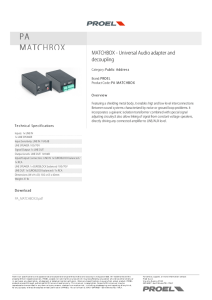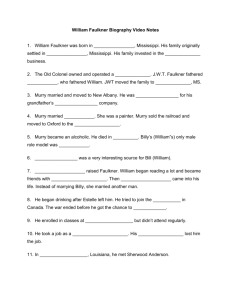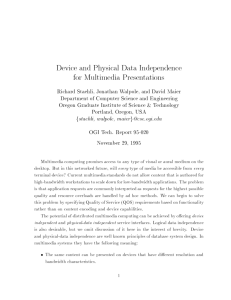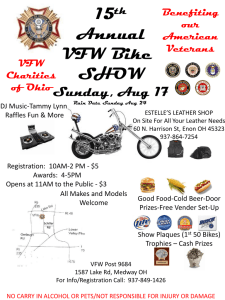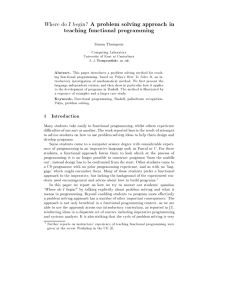using estelle to evolve mil-std 188-220
advertisement
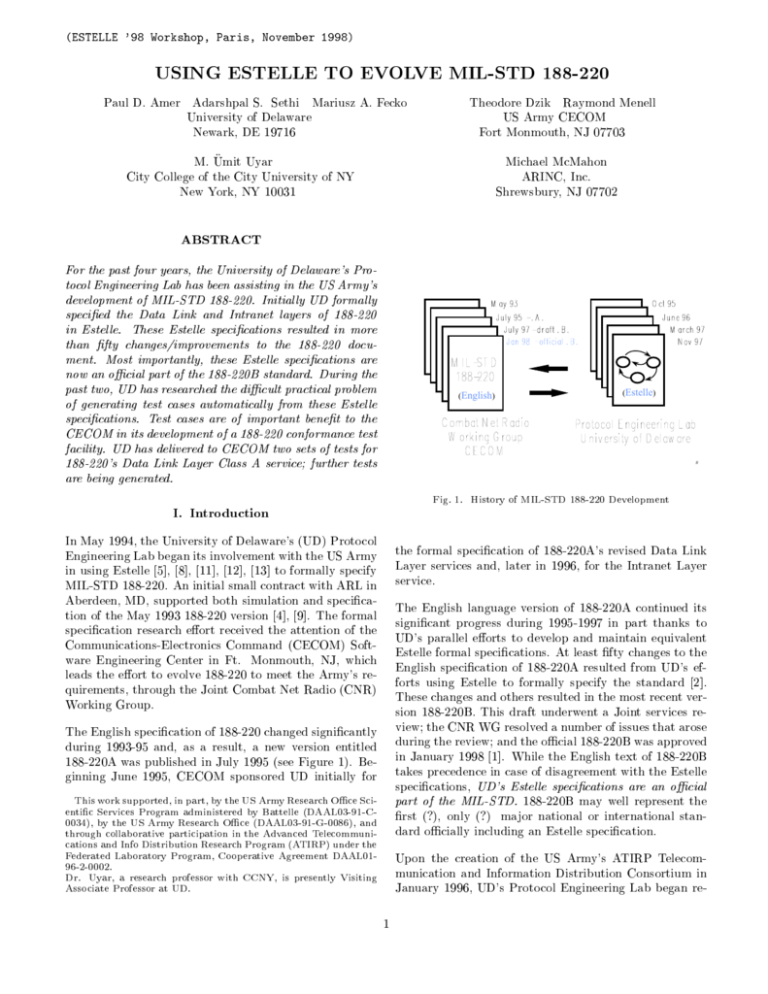
(ESTELLE '98 Workshop, Paris, November 1998)
USING ESTELLE TO EVOLVE MIL-STD 188-220
Paul D. Amer Adarshpal S. Sethi Mariusz A. Fecko
University of Delaware
Newark, DE 19716
Theodore Dzik Raymond Menell
US Army CECOM
Fort Monmouth, NJ 07703
M. U mit Uyar
City College of the City University of NY
New York, NY 10031
Michael McMahon
ARINC, Inc.
Shrewsbury, NJ 07702
ABSTRACT
For the past four years, the University of Delaware's Protocol Engineering Lab has been assisting in the US Army's
development of MIL-STD 188-220. Initially UD formally
specied the Data Link and Intranet layers of 188-220
in Estelle. These Estelle specications resulted in more
than fty changes/improvements to the 188-220 document. Most importantly, these Estelle specications are
now an ocial part of the 188-220B standard. During the
past two, UD has researched the dicult practical problem
of generating test cases automatically from these Estelle
specications. Test cases are of important benet to the
CECOM in its development of a 188-220 conformance test
facility. UD has delivered to CECOM two sets of tests for
188-220's Data Link Layer Class A service; further tests
are being generated.
(English)
(Estelle)
#
Fig. 1. History of MIL-STD 188-220 Development
I. Introduction
In May 1994, the University of Delaware's (UD) Protocol
Engineering Lab began its involvement with the US Army
in using Estelle [5], [8], [11], [12], [13] to formally specify
MIL-STD 188-220. An initial small contract with ARL in
Aberdeen, MD, supported both simulation and specication of the May 1993 188-220 version [4], [9]. The formal
specication research eort received the attention of the
Communications-Electronics Command (CECOM) Software Engineering Center in Ft. Monmouth, NJ, which
leads the eort to evolve 188-220 to meet the Army's requirements, through the Joint Combat Net Radio (CNR)
Working Group.
the formal specication of 188-220A's revised Data Link
Layer services and, later in 1996, for the Intranet Layer
service.
The English language version of 188-220A continued its
signicant progress during 1995-1997 in part thanks to
UD's parallel eorts to develop and maintain equivalent
Estelle formal specications. At least fty changes to the
English specication of 188-220A resulted from UD's efforts using Estelle to formally specify the standard [2].
These changes and others resulted in the most recent version 188-220B. This draft underwent a Joint services review; the CNR WG resolved a number of issues that arose
during the review; and the ocial 188-220B was approved
in January 1998 [1]. While the English text of 188-220B
takes precedence in case of disagreement with the Estelle
specications, UD's Estelle specications are an ocial
part of the MIL-STD. 188-220B may well represent the
rst (?), only (?) major national or international standard ocially including an Estelle specication.
The English specication of 188-220 changed signicantly
during 1993-95 and, as a result, a new version entitled
188-220A was published in July 1995 (see Figure 1). Beginning June 1995, CECOM sponsored UD initially for
This work supported, in part, by the US Army Research Oce Scientic Services Program administered by Battelle (DAAL03-91-C0034), by the US Army Research Oce (DAAL03-91-G-0086), and
through collaborative participation in the Advanced Telecommunications and Info Distribution Research Program (ATIRP) under the
Federated Laboratory Program, Cooperative Agreement DAAL0196-2-0002.
Dr. Uyar, a research professor with CCNY, is presently Visiting
Associate Professor at UD.
Upon the creation of the US Army's ATIRP Telecommunication and Information Distribution Consortium in
January 1996, UD's Protocol Engineering Lab began re1
search collaboration with CCNY. Together eorts were
expanded to automatically generate test cases from the
Estelle specications. This ATIRP-sponsored research directly supported CECOM's eorts to evolve 188-220 for
its battleeld digitization mission. Generating tests from
simple formal specications (ie., pure nite state machine
(FSM)) has been extensively studied in the literature. But
the inherent complexity of 188-220B is far beyond specifying with pure FSMs, hence the need to use a more
powerful specication language such as Estelle, ISO 9074.
Unfortunately, generating tests from Estelle specications
presents dicult theoretical and practical problems. With
ATIRP sponsorship, UD has and continues to investigate
these problems with the practical motivation of applying
the results towards 188-220B test case generation.
Test cases are important to CECOM's mission to develop
interoperable C4 I systems. These tests support a testing capability that can assure conformance and interoperability of 188-220B implementations. Based on several
research results [7], [14], [15], UD was able to generate an
initial set of tests for 188-220B's Data Link layer. The delivery of these automatically generated tests to CECOM
occurred in August 1997 and January 1998. This was a
major milestone of the ATIRP consortium demonstrating
how research support of Estelle test case generation resulted in tests that can assist CECOM's mission and the
Army.
receiving allied/international attention, while portions of
its protocol architecture have been promulgated in the Internet Engineering Task Force. Expected outcomes from
its use are expected to be seamless connectivity of C4 I systems, horizontally integrated information networks, and
joint interoperable C4 I systems for the warghter.
188-220 was originally developed in May 1993 as a joint
forces' standard to exchange Variable Message Format
messages between re support Digital Message Transfer
Devices (DMTDs) and automated C4 I systems.
Version 188-220B, whose architecture is depicted in Figure 2, describes the protocols needed to exchange messages using CNR as the transmission media. These protocols include the physical, data link and part of the network layer of the OSI model. The protocols apply to the
interface between host systems and radio systems. Hosts
usually, but not always, include communications processors or modems that implement these lower layer protocols. The unshaded portions of Figure 2 indicate those
protocols and extensions that were developed specically
for use with CNR.
The initial tests that were delivered were for one component of 188-220B's Data Link layer. UD is continuing to
study Estelle-based test case generation and to apply its
results to the entire set of Data Link layer services.
This paper provides the reader with a better understanding of the ongoing protocol engineering activity at UD to
evolve of 188-220. It is assumed that the reader is already
familiar with Estelle. The paper is organized as follows.
Section II overviews 188-220 and its primary function with
the Army plans for the digital battleeld. Section III describes in greater detail the tests that have been delivered
to CECOM as a result of UD's Estelle test case generation
research.
II. MIL-STD 188-220
The Protocol Engineering Lab researchers at UD used Estelle to specify parts of the 188-220 protocol suite. This
suite was developed to meet the requirements for horizontal integration, seamless internet communications and
increased mobility using combat network radios [6]. This
protocol, a critical piece of the new Joint-Army Technical
Architecture, is now mandated for CNR communications.
It is being implemented in U.S. Army, Navy and Marine Corps systems, and has been demonstrated initially
during the Army's Task Force XXI (TFXXI) Advanced
Warghting Experiment in March 1997. 188-220 is now
Fig. 2. MIL-STD 188-220B Protocol Architecture
The new Joint-Army Technical Architecture drives the
development of Army tactical C4 I systems implementing these standards. Army systems must build to these
blueprints to achieve interoperability and seamless communications for Task Force XXI Modernization.
The Joint CNR Working Group is ocially chartered under the DoD Data Communications Protocol Standards
Information Transfer Management Panel (IXMP). The
purpose of the WG was to initially develop the protocols,
and then address, resolve and document the solutions to
standards-related technical issues, that is, (1) to x any
incomplete, incorrect or unsuitable aspects of the standards; (2) support a rapid development process (for im-
plementers); and (3) document the resulting solutions and
standards changes, precluding each developer from choosing dierent (possibly proprietary or non-interoperable)
approaches.
The WG serves as a forum for focusing government and industry resources on resolving these issues. This teamwork
approach resulted in quick changes to the standard and
timely progression of the protocol's implementation for
TFXXI. WG participants have included representatives
from the DoD services/agencies, industry and academia.
III. Results: Test Case Generation
CECOM's Digital Integration Laboratory (DIL) is responsible for certifying that all systems that participated
in Task Force XXI were interoperable. To perform this
responsibility and future testing/certication for systems
communicating over CNR, the DIL requires automated
188-220B protocol test tools. The CECOM Software Engineering Center is developing a Conformance Tester that
automatically evaluates a 188-220B implementation identifying where it diers from the standard. This information can be used as a rst step in the DIL's certication process, or to objectively categorize a 188-220B implementation to guide future implementations and standard evolution. The Conformance Tester capability will
be used for the Army and the Army's joint requirements
for years to come.
In support of this task, UD's Protocol Engineering Lab is
developing test scripts to be used by the 188-220B Conformance Tester. The test scripts (a.k.a. test cases) specify
a logical sequence of test steps that are performed by a
Conformance Tester to individually test the Data Link
Layer (Classes A,B,C) and Intranet Layer.
The test scripts are input to the Conformance Tester
which in turn stimulates an Implementation Under Test
(IUT), and assesses responses to determine if the IUT correctly implements the protocols. Since it is impossible to
exhaustively test an implementation in practice, a good
set of test scripts should at least check those events that
aect state/transition, boundary conditions, and stress
points. The test scripts themselves should be structured
as independent modular components to facilitate modifying and adding to the scripts in response to 188-220's
continuing evolution.
As shown in Figure 3, the process that UD has taken in
generating tests is an indirect one. It would be ideal to be
able to generate tests directly from an Estelle specication. However with today's state-of-the-art testing knowledge, this is not yet possible. The Estelle language being
more powerful than pure FSMs in its specifying capability results in EFSMs that up to now are too complex for
direct test case generation. A second approach to solving
Fig. 3. Test Generation from Extended FSMs
the problem would be to expand Estelle's EFSMs thereby
converting them to pure FSMs. This would be useful
since methods exist for generating tests directly from pure
FSMs (e.g., [3]). Unfortunately, converting even simple
EFSMs can result in the state explosion problem, that
is, the resultant FSM has so many states and/or transitions that either it takes too long to generate tests, or the
number of tests generated is too large for practical use.
At UD, an intermediate approach has been investigated.
An Estelle EFSM is partially expanded (hence resulting
in some more states and transitions), but not expanded
completely to a pure FSM. The EFSM is expanded partially just enough to generate a set of tests that is feasible
and practical in size. Determining just what features to
expand in the general case is the dicult aspect of this
research.
Using some initial results, UD generated tests for the SAP
component of 188-220B's Data Link Layer Class A service.
The original EFSM specifying this functionality consists
of 1 state and 15 transitions. Since the total number of
possible test scenarios that would result after full expansion to a pure FSM is infeasibly large, the original EFSM
was converted to three EFSMs, each somewhat closer to
a pure FSM, but still containing some extensions. Each
of the new EFSMs focused on a separate functionality of
the Class A SAP service.
From the original EFSM with 1 state and 15 transitions,
three expanded EFSMs were derived having 398, 303,
and 112 states, and 799, 401, and 119 transitions, respectively. Using the expanded machines, UD's software
generated three sets of tests: set I consists of general behavior tests of the the SAP component interacting with
two destinations, set II tests datalink precedence, and set
tests an IUT's behavior when interacting with up to
sixteen destinations. The three sets involve 1732, 1428,
and 145 inputs/expected-outputs, respectively. Each sequence of inputs/outputs exercises every transition in the
corresponding expanded EFSM at least once. In August
1997, these tests were delivered to CECOM for use in its
188-220B testing facility.
III
The generated test sequences could be augmented to verify that the IUT is in the proper state after each input
is processed. This step will at least double and likely
even triple the test sequence length, hence making actual testing a longer process. UD is developing software
to generate tests that include state verication using UIO
sequences [10]. Current eorts at UD are on-going to generate tests for: the Station Component of the Data Link
Layer Class A service, the other Class services (B,C) and
the Intranet Layer.
REFERENCES
[1] Military Standard - Interoperability Standard for
Digital Message Device Subsystems (MIL-STD 188220B), 1998.
[2] P. Amer, G. Burch, A. Sethi, D. Zhu, T. Dzik,
R. Menell, and M. McMahon. Estelle specication
of MIL-STD 188-220A datalink layer. In Proc MILCOM '96, McLean, VA, Oct 1996.
[3] A. Aho, A. Dahbura, D. Lee, and M. Uyar. An optimization technique for protocol conformance test
generation based on UIO sequences and rural chinese postman tours. In S. Aggarwal and K. Sabnani,
eds, Protocol Specication, Testing, and Verication
VIII, 75{86, Amsterdam, 1988. North-Holland.
[4] R. Burch, P. Amer, and S. Chamberlain. Performance evaluation of MIL-STD 188-220A: Interoperability standard for digital message transfer device
subsystems. In Proc MILCOM '95, San Diego, CA,
Nov 1995.
[5] S. Budkowski and P. Dembinski. An intro to Estelle: A specication language for distributed systems. Computer Networks and ISDN Systems, 14(1),
3{23, 1987.
[6] T. Dzik and M. McMahon. MIL-STD 188-220A evolution: A model for technical architecture standards
development. In Proc MILCOM '97, Monterey, CA,
Nov 1997.
[7] M. Fecko, P. Amer, A. Sethi, M. Uyar, T. Dzik,
R. Menell, and M. McMahon. Formal design and
testing of MIL-STD 188-220A based on Estelle. In
Proc MILCOM '97, Monterey, CA, Nov 1997.
[8] Information Processing Systems | Open System Interconnection. ISO International Standard 9074: Estelle | A formal description technique based on an
extended state transition model.
[9] H. Li, P. Amer, and S. Chamberlain. Estelle specication of MIL-STD 188-220A: Interoperability stan-
[10]
[11]
[12]
[13]
[14]
[15]
dard for digital message transfer device subsystems.
In Proc MILCOM '95, San Diego, CA, Nov 1995.
K. Sabnani and A. Dahbura. A protocol test generation procedure. Computer Networks and ISDN
Systems, 15(4), 285{297, Sep 1988.
R. Tenney. A tutorial introduction to Estelle. Tech
Report 88{1, Univ of Mass, Boston, Jun 1988.
R. Tenney. Tutorial on Estelle and early testing. Tech
Report 97{4, Univ of Mass, Boston, 1997.
K. Turner, ed. Formal Description Techniques.
North-Holland, Amsterdam, 1989.
M. Uyar, M. Fecko, A. Sethi, and P. Amer.
Minimum-cost solutions for testing protocols with
timers. In Proc IEEE International Performance,
Computing, and Communications Conf, Phoenix,
Feb 1998.
U. Uyar, M. Fecko, A. Sethi, and P. Amer. Generation of realizable conformance tests under timing
constraints. In Proc MILCOM '98, Boston, Oct 1998.


